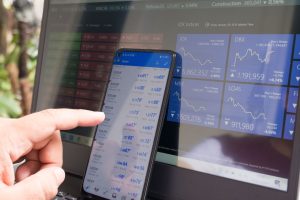The forex market is known for being highly liquid and volatile, with prices constantly fluctuating. One of the most interesting phenomena that occur in the forex market is gaps. These are sudden and significant price movements that occur when the market opens after a weekend or a holiday. They can be either positive or negative, and they can cause traders to either profit or lose money. In this article, we will explore the causes of forex market gaps, and what traders can do to manage them.
What are forex market gaps?
Forex market gaps occur when the price of a currency pair opens at a higher or lower level than the closing price of the previous trading day. This happens when there is a significant change in market sentiment or economic news that occurs outside of trading hours. Gaps can be either positive or negative, depending on whether the opening price is higher or lower than the previous day’s closing price.
Positive gaps occur when the opening price of a currency pair is higher than the previous day’s closing price. This usually happens when there is positive news that affects the currency pair, such as a strong economic report or a central bank decision to raise interest rates. Negative gaps occur when the opening price of a currency pair is lower than the previous day’s closing price. This usually happens when there is negative news that affects the currency pair, such as a weak economic report or a central bank decision to lower interest rates.
What causes forex market gaps?
There are several factors that can cause forex market gaps. The most common ones are:
1. Economic news and data releases
Economic news and data releases are one of the most significant drivers of forex market gaps. When a major economic report is released outside of trading hours, it can cause a significant change in market sentiment and lead to a gap when the market opens. For example, if a country’s GDP growth rate is higher than expected, it can lead to a positive gap in the currency pairs that are affected by that economy.
2. Political events
Political events can also cause forex market gaps. For example, if there is a sudden change in government or a significant policy decision is announced outside of trading hours, it can lead to a gap in the currency pairs that are affected by that country. Political events such as elections, referendums, and geopolitical tensions can all cause gaps in the forex market.
3. Central bank decisions
Central bank decisions, such as interest rate decisions, can also cause forex market gaps. When a central bank announces a change in interest rates or monetary policy outside of trading hours, it can lead to a significant change in market sentiment and cause a gap when the market opens. For example, if a central bank raises interest rates, it can lead to a positive gap in the currency pairs that are affected by that economy.
4. Liquidity issues
Liquidity issues can also cause forex market gaps. When there is low liquidity in the market, it can lead to wider bid-ask spreads and more significant price gaps. This usually happens during holidays or weekends when trading volumes are lower than usual.
5. Technical factors
Technical factors, such as stop-loss orders and algorithmic trading, can also cause forex market gaps. When a significant number of stop-loss orders are triggered at the same time, it can lead to a sudden drop in price and cause a negative gap. Algorithmic trading can also lead to gaps as automated trading systems react to sudden changes in market sentiment.
How can traders manage forex market gaps?
Forex market gaps can be both profitable and risky for traders. Traders can take advantage of positive gaps by buying the currency pair at the opening price and selling it at a higher price. However, negative gaps can cause significant losses if traders are caught on the wrong side of the trade. Here are some tips on how traders can manage forex market gaps:
1. Use stop-loss orders
Stop-loss orders are essential tools for managing risk in the forex market. Traders can use stop-loss orders to limit their losses in case of a negative gap. By setting a stop-loss order at a reasonable level, traders can minimize their losses if the market moves against them.
2. Monitor economic news and data releases
Traders should always be aware of economic news and data releases that can affect the currency pairs they are trading. By keeping up to date with the latest news, traders can anticipate potential gaps and adjust their positions accordingly.
3. Be aware of liquidity issues
Traders should also be aware of liquidity issues that can affect the forex market. During holidays or weekends, trading volumes are lower than usual, which can lead to wider bid-ask spreads and more significant price gaps. Traders should adjust their positions accordingly and avoid trading during low liquidity periods.
4. Use technical analysis
Technical analysis can be a helpful tool for predicting potential gaps in the forex market. By analyzing price charts and identifying key support and resistance levels, traders can anticipate potential gaps and adjust their positions accordingly.
Conclusion
Forex market gaps are a common occurrence in the forex market, and they can be both profitable and risky for traders. By understanding the causes of forex market gaps and using the right tools and strategies, traders can manage their risks and take advantage of potential opportunities. Traders should always be aware of economic news and data releases, liquidity issues, and technical factors that can affect the forex market and adjust their positions accordingly.






